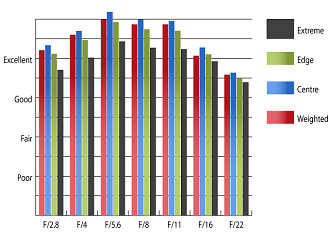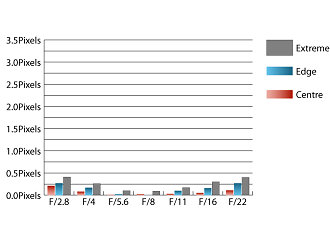Canon TS-E 45mm f/2.8 Lens Review
Canon TS-E 45mm f/2.8 Performance
As you may expect from one of Canon's premium optics, performance is excellent within the limits of the 35mm frame, even at maximum aperture. With the lens fully shifted, sharpness toward the edge of the image circle is slightly reduced at maximum aperture, although sharpness is still very good. Stopping down to f/5.6 or beyond results in outstanding sharpness, no matter how much shift is applied.
How to read our charts
The blue column represents readings from the centre of the picture frame at the various apertures and the green is from the edges. Averaging them out gives the red weighted column.The scale on the left side is an indication of actual image resolution. The taller the column, the better the lens performance. Simple.
For this review, the lens was tested on a Canon EOS 5D Mark III using Imatest.
Chromatic aberrations are extremely well controlled, even towards the furthest edges of the image circle, with fringing falling way below half a pixel width at maximum aperture. This low level of fringing should be very hard to spot, even in harsh crops from the edges of the image circle, or in large reproductions of images taken with the lens.
How to read our charts
Chromatic aberration is the lens' inability to focus on the sensor or film all colours of visible light at the same point. Severe chromatic aberration gives a noticeable fringing or a halo effect around sharp edges within the picture. It can be cured in software.Apochromatic lenses have special lens elements (aspheric, extra-low dispersion etc) to minimize the problem, hence they usually cost more.
For this review, the lens was tested on a Canon EOS 5D Mark III using Imatest.
Due to the nature of the lens, it isn't possible to accurately measure the falloff across the whole image circle with Imatest. Across the normal 35mm frame with the fully shifted, the corners of the image are 3.56 stops darker than the image centre at maximum aperture and uniform illumination is achieved with the lens stopped down to f/8 or beyond. As is the case with other tilt-shift optics, applying a severe tilt will darken the image in the viewfinder.
Distortion is a little higher than you may have expected from a lens of this type. Imatest detected 1.15% barrel distortion, which is still extremely mild, be may be possible to spot in straight lines parallel to the edges of the frame
Contrast is good, even when shooting into the light, and this lens is quite resistant to flare too.
Value For Money
With a price of £1000 from some UK suppliers, this lens is priced fairly reasonably for a specialised optic, especially one that delivers such high quality.
For purposes of comparison, the Nikon 45mm PC-E f/2.8D Micro Nikkor lens costs around £300 more, but it does focus much closer, providing half life size magnification without extension tubes.
Add your message
Please login here or if you've not registered, you can register here. Registering is safe, quick and free.
photodo Stats
428 MTF tests
74 in-depth photodo reviews
100+ users join each day
Help the lens community by reviewing or rating a lens today via our lens search
Latest Lens Reviews
- Chinon 28mm f/2.8 Vintage Lens Review
- Canon EF 70-200mm f/4L IS II USM Lens Review
- Samyang AF 85mm f/1.4 EF Review
- Sigma 70mm f/2.8 DG Macro Art Review
- Samyang AF 24mm f/2.8 FE Review
- Meike 50mm f/1.7 Review
- Tamron 70-210mm f/4 Di VC USD Review
- Lensbaby Burnside 35mm f/2.8 Review
- Asahi Super Takumar 50mm f/1.4 Review
- Asahi Super-Multi-Coated Takumar 135mm f/3.5 Review


